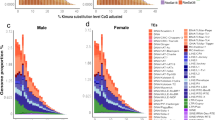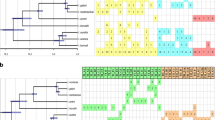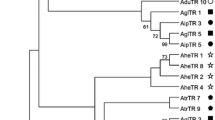Abstract
Here, we analyze the evolutionary dynamics of a satellite-DNA family in an attempt to understand the effect of factors such as location, organization, and repeat-copy number in the molecular drive process leading to the concerted-evolution pattern found in this type of repetitive sequences. The presence of RAE180 satellite-DNA in the dioecious species of the plant genus Rumex is a noteworthy feature at this respect, as RAE180 satellite repeats have accumulated differentially, showing a distinct distribution pattern in different species. The evolution of dioecious Rumex gave rise to two phylogenetic clades: one clade composed of species with an ancestral XX/XY sex chromosome system and a second, derived clade of species with a multiple sex–chromosome system XX/XY1Y2. While in the XX/XY dioecious species, the RAE180 satellite-DNA is located only in a small autosomal locus, the RAE180 repeats are present also in a small autosomal locus and additionally have been massively amplified in the Y chromosomes of XX/XY1Y2 species. Here, we have found that the RAE180 repeats of the autosomal locus of XX/XY species are characterized by intra-specific sequence homogeneity and inter-specific divergence and that the comparison of individual nucleotide positions between related species shows a general pattern of concerted evolution. On the contrary, both in the autosomal and the Y-linked loci of XX/XY1Y2 species, ancestral variability has remained with reduced rates of sequence homogenization and of evolution. Thus, this study demonstrates that molecular mechanisms of non-reciprocal exchange are key factors in the molecular drive process; the satellite DNAs in the non-recombining Y chromosomes show low rates of concerted evolution and intra-specific variability increase with no inter-specific divergence. By contrast, freely recombining loci undergo concerted evolution with genetic differentiation between species as occurred in the autosomal locus of XX/XY species. However, evolutionary periods of rapid sequence change might alternate with evolutionary periods of stasis with variability remaining by the reduced action of molecular mechanisms of non-reciprocal exchange as occurred in XX/XY1Y2 species, which could depend on repeat-copy number and the processes involved in their amplification.





Similar content being viewed by others
References
Ainsworth CC, Lu J, Winfield M, Parker JS (1999) Sex determination by X:autosome dosage: Rumex acetosa (sorrel). In: Ainsworth CC (ed) Sex determination in plants. BIOS Scientific Publishers Limited, Oxford, pp 124–136
Bachmann L, Sperlich D (1993) Gradual evolution of a specific satellite DNA family in Drosophila ambigua, D. tristis, and D. obscura. Mol Biol Evol 10:647–659
Bennett MD, Leitch IJ (2004) Plant DNA C-values database. Release 3.0
Cuñado N, Navajas-Pérez R, de la Herrán R, Ruiz Rejón C, Ruiz Rejón M, Santos JL, Garrido-Ramos MA (2007) The evolution of sex chromosomes in the genus Rumex (Polygonaceae): identification of a new species with heteromorphic sex chromosomes. Chromosome Res 15:825–832
Degraeve N (1975) Contribution à l′étude cytotaxonomique des Rumex. I Le genre Rumex. Caryologia 28:187–251
Degraeve N (1976) Contribution à l′étude cytotaxonomique des Rumex. IV Le genre Acetosa Mill. Cellule 71:231–240
Degraeve N (1980) Contribution a l’etude cytotaxonomique des Rumex. III Le genre Acetosella Fourr. Genetica 54:29–34
Dover G (2002) Molecular drive. Trends Genet 18:587–589
Feliciello I, Picariello O, Chinali G (2005) The first characterisation of the overall variability of repetitive units in a species reveals unexpected features of satellite DNA. Gene 349:153–164
Feliciello I, Picariello O, Chinali G (2006) Intra-specific variability and unusual organization of the repetitive units in a satellite DNA from Rana dalmatina: molecular evidence of a new mechanism of DNA repair acting on satellite DNA. Gene 383:81–92
Felsenstein J (1985) Confidence limits on phylogenies: an approach using the bootstrap. Evolution 39:783–791
Gaut BS (1998) Molecular clocks and nucleotide substitution rates in higher plants. Evol Biol 30:93–120
Meštrović N, Castagnone-Sereno P, Plohl M (2006) Interplay of selective pressure and stochastic events directs evolution of the MEL172 satellite DNA library in root-knot nematodes. Mol Biol Evol 23:2316–2325
Miller WJ, Nagel A, Bachmann J, Bachmann L (2000) Evolutionary dynamics of the SGM transposon family in the Drosophila obscura species group. Mol Biol Evol 17:1597–1609
Mravinac B, Plohl M, Meštrović N, Ugarković Đ (2002) Sequence of PRAT satellite DNA “frozen” in some Coleopteran species. J Mol Evol 54:774–783
Navajas-Pérez R, de la Herrán R, López González G, Jamilena M, Lozano R, Ruiz Rejón C, Ruiz Rejón M, Garrido-Ramos MA (2005a) The evolution of reproductive systems and sex-determining mechanisms within Rumex (Polygonaceae) inferred from nuclear and chloroplastidial sequence data. Mol Biol Evol 22:1929–1939
Navajas-Pérez R, de la Herrán R, Jamilena M, Lozano R, Ruiz Rejón C, Ruiz Rejón M, Garrido-Ramos MA (2005b) Reduced rates of sequence evolution of Y-linked satellite DNA in Rumex (Polygonaceae). J Mol Evol 60:391–399
Navajas-Pérez R, Schwarzacher T, de la Herrán R, Ruiz Rejón C, Ruiz Rejón M, Garrido-Ramos MA (2006) The origin and evolution of the variability in a Y-specific satellite-DNA of Rumex acetosa and its relatives. Gene 368:61–71
Navajas-Pérez R, Ruiz Rejón M, Garrido-Ramos MA, Aznarte JL, Rubio-Escudero C (2007a) SatDNA Analyzer: a computing tool for satellite-DNA evolutionary analysis. Bioinformatics 23:767–768
Navajas-Pérez R, Rubio-Escudero C, Aznarte JL, Ruiz Rejón M, Garrido-Ramos MA (2007b) SatDNA Analyzer 1.2 as a valuable computing tool for evolutionary analysis of satellite-dna families: revisiting Y-linked satellite-DNA sequences of Rumex (Polygonaceae). In: Hochreiter S, Wagner R (eds) Lecture notes in computer sciences, bioinformatics research and development, vol 4414. Springer-Verlag, Berlin, pp 131–139
Navajas-Pérez R, Schwarzacher T, Ruiz Rejón M, Garrido-Ramos MA (2009) Molecular cytogenetic characterization of Rumex papillaris, a dioecious plant with an XX/XY1Y2 sex chromosome system. Genetica 135:87–93
Nei M (1987) Molecular evolutionary genetics. Columbia University Press, New York
Ohta T, Dover G (1984) The cohesive population genetics of molecular drive. Genetics 108:501–521
Pons J, Gillespie RG (2003) Common origin of the satellite DNAs of the Hawaiian spiders of the genus Tetragnatha: evolutionary constraints on the length and nucleotide composition of the repeats. Gene 313:169–177
Pons J, Petitpierre E, Juan C (2002) Evolutionary dynamics of satellite DNA family PIM357 in species of the genus Pimelia (Tenebrionidae, Coleoptera). Mol Biol Evol 19:1329–1340
Saito N, Nei M (1987) The neighbor-joining method: a new method for reconstructing phylogenetic trees. Mol Biol Evol 4:406–425
Smith BW (1969) Evolution of sex-determining mechanisms in Rumex. Chromosomes Today 2:172–182
Smith GP (1976) Evolution of repeated DNA sequences by unequal crossover. Science 191:528–535
Strachan T, Webb D, Dover G (1985) Transition stages of molecular drive in multiple-copy DNA families in Drosophila. EMBO J 4:1701–1708
Tamura K, Dudley J, Nei M, Kumar S (2007) MEGA4: Molecular Evolutionary Genetics Analysis (MEGA) software version 4.0. Mol Biol Evol 24:1596–1599
Thompson JD, Gibson TJ, Plewniak F, Jeanmougin F, Higgins DG (1997) The ClustalX windows interface: flexible strategies for multiple sequence alignment aided by quality analysis tools. Nucleic Acids Res 24:4876–4882
Ugarkovic D, Plohl M (2002) Variation in satellite DNA profiles—causes and effects. EMBO J 21:5955–5959
Wilby AS, Parker JS (1988) Recurrent patterns of chromosome variation in a species group. Heredity 61:55–62
Acknowledgments
Our thanks to Dr. Ginés López González (Real Jardín Botánico de Madrid, Spain), and to the Parque Nacional de Sierra Nevada and to the Parque Natural de la Sierra de Baza, for kindly providing the material analyzed in this article. We also are deeply indebted to Dr. Miguel Burgos of the University of Granada for advice and help with the satellite-DNA quantification procedure. This research was supported by grant CGL2006-00444/BOS of the Ministerio of Ciencia e Innovación (Spain) and Fondo Europeo de Desarrollo Regional (FEDER, EU).
Author information
Authors and Affiliations
Corresponding author
Additional information
Communicated by S. Hohmann.
R. Navajas-Pérez and M. E. Quesada del Bosque contributed equally to this work.
Electronic supplementary material
Below is the link to the electronic supplementary material.
Supplementary material Sm1
Graphic representation of patterns of distributions of mutations at individual nucleotide positions across repeats a–f in two species, A and B (modified from Strachan et al. 1985 and from Pons et al. 2002). SP A-B . Shared polymorphic site between species A and B. The same mutation (black circles) is shared by some repeats of both species. I–VI. Transition stages during the spread of new mutations in the molecular drive process: Classes I–VI. Class I represents complete homogeneity across all repeats randomly sampled from a pair of species (white circles). Classes II, III, and IV would represent intermediate stages where a new mutation (black circle) is gradually spread throughout the satellite-DNA family in one species, whereas the other species remains homogeneous for the progenitor base in the corresponding position. All subsequent mutations (grey circle) beyond this point are represented by the pattern shown in class VI. (PDF 15.3 kb)
Supplementary material Sm2
Multiple sequence alignment for RAE180 sequences from R. suffruticosus and R. acetosella (PDF 9.18 kb)
Supplementary material Sm3
Multiple sequence alignment for RAE180 sequences from R. acetosa and R. papillaris (PDF 8.04 kb)
Rights and permissions
About this article
Cite this article
Navajas-Pérez, R., Quesada del Bosque, M.E. & Garrido-Ramos, M.A. Effect of location, organization, and repeat-copy number in satellite-DNA evolution. Mol Genet Genomics 282, 395–406 (2009). https://doi.org/10.1007/s00438-009-0472-4
Received:
Accepted:
Published:
Issue Date:
DOI: https://doi.org/10.1007/s00438-009-0472-4




